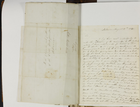Multimedia Content

Letter to Public Works Committee from John Harper, 15 August 1843, courtesy of Public Record Office Victoria, Victorian Archives Centre.
Details
Quarries and Brickmaking
Melbourne sits on a rich basalt layer, extending from the west of the city to the South Australian border, guaranteeing an abundant supply of bluestone for the city's builders. The first quarries, which opened in the 1830s and 1840s, were located in the Fitzroy Gardens, Carlton and Clifton Hill. During the second half of the 19th century, quarrying spread west and north, with quarries opening in Williamstown, Footscray and Brunswick and, towards the end of the century, in Coburg and Preston.
During the gold rushes, much of the stone quarried in Melbourne was used to provide ballast for returning ships, but quarries also produced bluestone for many of the city's major buildings. Footscray quarries, for example, provided bluestone for the foundations of Parliament House, the old Treasury Building, Melbourne Town Hall, St Paul's Cathedral, the General Post Office, Flinders Street Station and the Argus offices at 365 Elizabeth Street. Quarries in Clifton Hill, worked by convicts from the Collingwood Stockade in Carlton North, produced stone for Pentridge Prison.
In part because of the expense of transporting bluestone, bricks gradually came to replace stone as the preferred building material. Hoffman Brick & Potteries Ltd in Brunswick, one of Melbourne's first brickworks (1870), was quickly followed by Butler's Brickworks (1879), Fritsch Holtzer & Co. (1880) and the Northcote Brick Co. (1882). The first brick clay pits were located in the inner suburbs, close to the areas of greatest building activity. By the 1860s there were more than 40 brickworks and potteries in Brunswick alone. But the industry gradually spread east, with works established in Box Hill, Nunawading, Oakleigh and Camberwell. Many brickworks manufactured not only bricks, but also building materials such as roof tiles and domestic items such as mixing bowls and garden pots. Hoffman's brickworks in Brunswick also had a major role in manufacturing pipes for Melbourne's sewerage works.
In 1896 a number of brick manufacturers joined together to form the Co-operative Brick Co. with the aim of reducing their costs and regulating brick prices. Despite complaints about the resulting price increases, the 1914 Royal Commission on the Brick Manufacturing Industry of Victoria found that the prices charged for Melbourne bricks were fair and the quality high. As a result of the depression and diminishing clay supplies, many of Melbourne's brickworks scaled down production in the 1930s, with the disused clay pits and quarries used for rubbish and garbage disposal or swimming holes and, once filled in, converted into parks or shopping centres (such as Highpoint City, Altona Gate and Northcote Plaza).
- References
- Himbury, Aenea, 'As long as you could see the Hoffman's chimneys, you wasn't lost': saving Brunswick's brickworks, Save the Brickworks, Melbourne, 2000. Details
- Ross, Sandy, Bricks by the million: a brief history of Lilydale's brick making industry, Lilydale and District Historical Society, Melbourne, 1996. Details
- Vines, Garry, Quarry and stone: bluestone quarrying, stonemasonry and building in Melbourne's west, Melbourne's Living Museum of the West, Melbourne, 1993. Details
